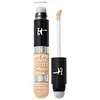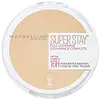IT Cosmetics Bye Bye Dark Spots Concealer + Serum Versus Maybelline Super Stay Full Coverage Powder Foundation
What's inside
What's inside
 Key Ingredients
Key Ingredients

 Benefits
Benefits

 Concerns
Concerns

 Ingredients Side-by-side
Ingredients Side-by-side

Water
Skin ConditioningCoco-Caprylate/Caprate
EmollientHydrogenated Polyisobutene
EmollientGlycerin
HumectantPropanediol
SolventPropylene Glycol
HumectantSorbitan Isostearate
EmulsifyingPolyglyceryl-6 Polyricinoleate
EmulsifyingNiacinamide
SmoothingSynthetic Fluorphlogopite
Hydroxyethylpiperazine Ethane Sulfonic Acid
BufferingPhenoxyethanol
PreservativeMagnesium Sulfate
Disodium Stearoyl Glutamate
CleansingParaffin
PerfumingHydroxyacetophenone
AntioxidantDisteardimonium Hectorite
StabilisingCera Microcristallina
Emulsion StabilisingCaprylyl Glycol
EmollientSilica Silylate
EmollientSilica
AbrasiveSynthetic Wax
AbrasiveCaffeine
Skin ConditioningCentella Asiatica Extract
CleansingTrisodium Ethylenediamine Disuccinate
Aluminum Hydroxide
EmollientTocopherol
AntioxidantAdenosine
Skin ConditioningSodium Hyaluronate
HumectantHydrated Silica
AbrasiveHelianthus Annuus Seed Oil
EmollientMethicone
EmollientCI 77891
Cosmetic ColorantCI 77491
Cosmetic ColorantCI 77492
Cosmetic ColorantCI 77499
Cosmetic ColorantCI 77007
Cosmetic ColorantCI 15985
Cosmetic ColorantCI 42090
Cosmetic ColorantCI 45410
Cosmetic ColorantCI 15850
Cosmetic ColorantWater, Coco-Caprylate/Caprate, Hydrogenated Polyisobutene, Glycerin, Propanediol, Propylene Glycol, Sorbitan Isostearate, Polyglyceryl-6 Polyricinoleate, Niacinamide, Synthetic Fluorphlogopite, Hydroxyethylpiperazine Ethane Sulfonic Acid, Phenoxyethanol, Magnesium Sulfate, Disodium Stearoyl Glutamate, Paraffin, Hydroxyacetophenone, Disteardimonium Hectorite, Cera Microcristallina, Caprylyl Glycol, Silica Silylate, Silica, Synthetic Wax, Caffeine, Centella Asiatica Extract, Trisodium Ethylenediamine Disuccinate, Aluminum Hydroxide, Tocopherol, Adenosine, Sodium Hyaluronate, Hydrated Silica, Helianthus Annuus Seed Oil, Methicone, CI 77891, CI 77491, CI 77492, CI 77499, CI 77007, CI 15985, CI 42090, CI 45410, CI 15850
Talc
AbrasiveMagnesium Stearate
Cosmetic ColorantPolymethyl Methacrylate
Synthetic Fluorphlogopite
Isononyl Isononanoate
EmollientNylon-12
Hydrogenated Polydecene
EmollientVinyl Dimethicone/Methicone Silsesquioxane Crosspolymer
Diphenyl Dimethicone/Vinyl Diphenyl Dimethicone/Silsesquioxane Crosspolymer
Aluminum Hydroxide
EmollientDimethicone
EmollientPerfluorooctyl Triethoxysilane
Ethylhexylglycerin
Skin ConditioningLauroyl Lysine
Skin ConditioningMethicone
EmollientHydrogenated Palm Oil
EmollientPalmitoyl Proline
Skin ConditioningGlycerin
HumectantHydrogen Dimethicone
Water
Skin ConditioningSodium Palmitoyl Sarcosinate
CleansingMagnesium Palmitoyl Glutamate
Skin ConditioningPalmitic Acid
EmollientPhenoxyethanol
PreservativeMoringa Oleifera Seed Extract
Skin ConditioningDisodium Phosphate
BufferingCitric Acid
BufferingTocopherol
AntioxidantCI 77891
Cosmetic ColorantMica
Cosmetic ColorantCI 77491
Cosmetic ColorantCI 77492
Cosmetic ColorantCI 77499
Cosmetic ColorantTalc, Magnesium Stearate, Polymethyl Methacrylate, Synthetic Fluorphlogopite, Isononyl Isononanoate, Nylon-12, Hydrogenated Polydecene, Vinyl Dimethicone/Methicone Silsesquioxane Crosspolymer, Diphenyl Dimethicone/Vinyl Diphenyl Dimethicone/Silsesquioxane Crosspolymer, Aluminum Hydroxide, Dimethicone, Perfluorooctyl Triethoxysilane, Ethylhexylglycerin, Lauroyl Lysine, Methicone, Hydrogenated Palm Oil, Palmitoyl Proline, Glycerin, Hydrogen Dimethicone, Water, Sodium Palmitoyl Sarcosinate, Magnesium Palmitoyl Glutamate, Palmitic Acid, Phenoxyethanol, Moringa Oleifera Seed Extract, Disodium Phosphate, Citric Acid, Tocopherol, CI 77891, Mica, CI 77491, CI 77492, CI 77499
 Reviews
Reviews

Ingredients Explained
These ingredients are found in both products.
Ingredients higher up in an ingredient list are typically present in a larger amount.
Aluminum Hydroxide is a form of aluminum. It can be naturally found in nature as the mineral gibbsite. In cosmetics, Aluminum Hydroxide is used as a colorant, pH adjuster, and absorbent.
As a colorant, Aluminum Hydroxide may add opacity, or reduce the transparency. Aluminum hydroxide is contains both basic and acidic properties.
According to manufacturers, this ingredient is an emollient and humectant. This means it helps hydrate the skin.
In medicine, this ingredient is used to help relieve heartburn and help heal ulcers.
There is currently no credible scientific evidence linking aluminum hydroxide in cosmetics to increased cancer risk.
Major health organizations allow the use of aluminum hydroxide in personal care products and have not flagged it as a carcinogenic risk at typical usage levels.
Learn more about Aluminum HydroxideCi 77491 is also hydrated iron III oxide. It's sole purpose is to give a red/pink hue to products.
Iron III oxides are classified as inorganic chemicals for coloring.
Synthetically created Ci 77491 is considered safer than those naturally found. This is because the synthetically created version may contain less impurities. Iron oxides are generally non-toxic and non-allergenic.
Learn more about CI 77491Ci 77492 is also hydrated iron III oxide. It's sole purpose is to give a yellow hue to products.
Iron III oxides are classified as inorganic chemicals for coloring.
Synthetically created Ci 77492 is considered safer than those naturally found. This is because the synthetically created version may contain less impurities. Iron oxides are generally non-toxic and non-allergenic.
Learn more about CI 77492Ci 77499 is also hydrated iron III oxide. It is created from mixing red and black iron oxides. This helps give shades of darkness to a product.
Iron III oxides are classified as inorganic chemicals for coloring.
Ci 77891 is a white pigment from Titanium dioxide. It is naturally found in minerals such as rutile and ilmenite.
It's main function is to add a white color to cosmetics. It can also be mixed with other colors to create different shades.
Ci 77891 is commonly found in sunscreens due to its ability to block UV rays.
Learn more about CI 77891Glycerin is already naturally found in your skin. It helps moisturize and protect your skin.
A study from 2016 found glycerin to be more effective as a humectant than AHAs and hyaluronic acid.
As a humectant, it helps the skin stay hydrated by pulling moisture to your skin. The low molecular weight of glycerin allows it to pull moisture into the deeper layers of your skin.
Hydrated skin improves your skin barrier; Your skin barrier helps protect against irritants and bacteria.
Glycerin has also been found to have antimicrobial and antiviral properties. Due to these properties, glycerin is often used in wound and burn treatments.
In cosmetics, glycerin is usually derived from plants such as soybean or palm. However, it can also be sourced from animals, such as tallow or animal fat.
This ingredient is organic, colorless, odorless, and non-toxic.
Glycerin is the name for this ingredient in American English. British English uses Glycerol/Glycerine.
Learn more about GlycerinMethicone is a type of silicone and is a simpler form of dimethicone.
Silicones are used to enhance the texture of products and have emollient properties. Methicone is used to give products a silky texture and improves spreadability.
Phenoxyethanol is a preservative that has germicide, antimicrobial, and aromatic properties. Studies show that phenoxyethanol can prevent microbial growth. By itself, it has a scent that is similar to that of a rose.
It's often used in formulations along with Caprylyl Glycol to preserve the shelf life of products.
Synthetic Fluorphlogopite is the synthethic version of mica. It consists of fluorine, aluminum and silicate.
Synthetic Fluorphlogopite is used to add volume to products.
It is considered non-irritating on the skin.
Learn more about Synthetic FluorphlogopiteTocopherol (also known as Vitamin E) is a common antioxidant used to help protect the skin from free-radicals and strengthen the skin barrier. It's also fat soluble - this means our skin is great at absorbing it.
Vitamin E also helps keep your natural skin lipids healthy. Your lipid skin barrier naturally consists of lipids, ceramides, and fatty acids. Vitamin E offers extra protection for your skin’s lipid barrier, keeping your skin healthy and nourished.
Another benefit is a bit of UV protection. Vitamin E helps reduce the damage caused by UVB rays. (It should not replace your sunscreen). Combining it with Vitamin C can decrease sunburned cells and hyperpigmentation after UV exposure.
You might have noticed Vitamin E + C often paired together. This is because it is great at stabilizing Vitamin C. Using the two together helps increase the effectiveness of both ingredients.
There are often claims that Vitamin E can reduce/prevent scarring, but these claims haven't been confirmed by scientific research.
Learn more about TocopherolWater. It's the most common cosmetic ingredient of all. You'll usually see it at the top of ingredient lists, meaning that it makes up the largest part of the product.
So why is it so popular? Water most often acts as a solvent - this means that it helps dissolve other ingredients into the formulation.
You'll also recognize water as that liquid we all need to stay alive. If you see this, drink a glass of water. Stay hydrated!
Learn more about Water